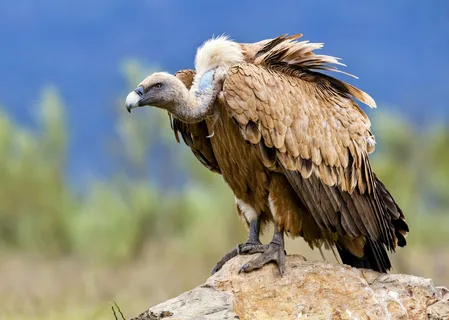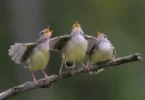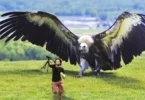In the intricate tapestry of the animal kingdom, certain avian species stand out not only for their elegance but also for their potential danger.
These birds, often possessing sharp talons, powerful beaks, or venomous defenses, command respect and caution from both fellow creatures and human observers.
From the majestic raptors soaring through the skies to the stealthy predators lurking in dense forests, dangerous birds hold a unique place in our collective fascination with wildlife.
This article delves into the realm of avian danger, exploring some of the most formidable and intriguing birds found across the globe.
From their remarkable adaptations to their impact on ecosystems and human interactions, readers will gain insights into the diverse array of avian threats and understand the significance of these creatures in the natural world.
Join us on this journey as we uncover the allure and peril of dangerous birds, shedding light on their role in shaping our perceptions of wildlife and the environment.
dangerous birds in the world
Characteristics of Dangerous Birds:
Dangerous birds possess an impressive array of physical and behavioral traits that set them apart as formidable predators or defenders. One of the most striking features of these avian species is their weaponry – sharp beaks and powerful talons capable of inflicting serious harm. Take, for example, the harpy eagle of South America, known for its massive talons that can exert a force of up to 500 pounds per square inch, making it a fearsome hunter in the rainforest canopy.
Beyond their physical attributes, dangerous birds also exhibit territorial behavior that can escalate into aggression. Birds like the southern cassowary of Australia and New Guinea fiercely defend their territories, using their dagger-like claws to deter intruders. This territoriality serves as a crucial survival strategy, ensuring access to resources and mating opportunities in competitive environments.
Moreover, many dangerous birds have evolved specialized adaptations to enhance their predatory or defensive capabilities. The peregrine falcon, for instance, boasts incredible speed and maneuverability, enabling it to dive at speeds exceeding 240 miles per hour to capture prey mid-flight. Such adaptations have evolved over millennia through natural selection, allowing these birds to thrive in their respective ecosystems by outcompeting rivals and exploiting niche opportunities.
In summary, the physical and behavioral characteristics of dangerous birds are finely tuned for survival in their often harsh and competitive environments. From razor-sharp beaks to territorial displays, these traits have evolved through the relentless pressures of natural selection, shaping these birds into some of the most effective and awe-inspiring predators in the animal kingdom. Understanding these characteristics not only enriches our appreciation of avian diversity but also underscores the importance of conservation efforts to protect these remarkable creatures and the ecosystems they inhabit.
Top 5 Dangerous Birds Worldwide:
1. Cassowary:
The cassowary, a native of the rainforests of Australia and New Guinea, cuts an imposing figure with its jet-black plumage, vivid blue neck, and distinctive helmet-like casque atop its head. This flightless bird inhabits dense forests where it roams in search of fruits, insects, and small animals. However, what truly sets the cassowary apart is its reputation as one of the world’s most dangerous birds.
Equipped with razor-sharp talons and a powerful kick that can rival the force of a sledgehammer, the cassowary poses a significant threat to any perceived threat to its territory. Numerous documented cases attest to the bird’s aggression towards humans, with attacks resulting in serious injuries and, in rare instances, fatalities. One such incident involved a jogger in Florida who was kicked to death by a cassowary he kept on his property as a pet, highlighting the potential dangers of interacting with these formidable birds.
2. Ostrich:
The ostrich, the largest bird in the world, is renowned for its towering stature, exceptional speed, and formidable defensive capabilities. Native to the savannas and deserts of Africa, this flightless giant can reach speeds of up to 45 miles per hour, making it a formidable opponent when threatened. Despite its typically docile nature, ostriches can become aggressive if provoked, using their powerful legs and sharp claws to defend themselves.
Instances of ostrich attacks on humans are relatively rare but can result in serious injuries due to the bird’s sheer size and strength. In one notable case, a zookeeper in Australia was kicked by an ostrich during feeding, sustaining severe injuries to his abdomen and legs. Despite their potential danger, ostriches play a vital role in their ecosystems, acting as seed dispersers and shaping vegetation through their grazing habits.
3. Southern Cassowary:
A close relative of the cassowary, the southern cassowary inhabits the dense rainforests of northeastern Australia and New Guinea. Distinguished by its vibrant blue skin and distinctive casque, this elusive bird feeds primarily on fruits, fungi, and small animals. While similar in appearance to its northern counterpart, the southern cassowary is slightly smaller and tends to inhabit lower-altitude habitats.
Despite its seemingly docile demeanor, the southern cassowary can exhibit aggressive behavior when threatened or provoked. Several documented incidents have occurred where humans have been attacked by these birds, resulting in serious injuries. In one such case, a tourist in Queensland was kicked by a southern cassowary while attempting to take a photograph, underscoring the importance of respecting these creatures’ space and boundaries.
4. Emu:
The emu, native to Australia, is the second-largest bird in the world after the ostrich, known for its long neck, powerful legs, and distinctive plumage. Unlike other dangerous birds, emus typically avoid confrontation but can become aggressive if provoked or cornered. Their powerful legs, armed with sharp claws, can inflict significant injuries on perceived threats.
Instances of emu encounters with humans are relatively common, particularly in rural areas where these birds may come into conflict with livestock or infrastructure. In one notable case, an emu broke into a schoolyard in Western Australia, causing chaos and injuring several students before being safely removed. Despite their occasional encounters with humans, emus play a vital role in their ecosystems as seed dispersers and contributors to soil health through their foraging habits.
5. Harpy Eagle:
The harpy eagle, native to the rainforests of Central and South America, is one of the largest and most powerful birds of prey in the world. With its striking black-and-white plumage, massive talons, and piercing gaze, this apex predator strikes fear into the hearts of its prey. Harpy eagles primarily hunt arboreal mammals such as sloths and monkeys, using their powerful talons to grasp and immobilize their quarry.
While not typically considered a threat to humans, harpy eagles can become aggressive if their nests are approached or disturbed. Instances of harpy eagle attacks on humans are rare but have been reported in cases where individuals ventured too close to nesting sites. In one documented incident, a wildlife photographer sustained minor injuries after being dive-bombed by a protective harpy eagle while attempting to capture images of its nest.
In conclusion, the world is home to a diverse array of dangerous birds, each possessing unique characteristics and behaviors that command respect and caution. From the formidable cassowary to the majestic harpy eagle, these avian predators play a crucial role in shaping their ecosystems and serve as powerful reminders of the wild beauty and inherent risks of nature. As we continue to explore and interact with the natural world, it is essential to approach these creatures with reverence and appreciation for their role in the intricate web of life.
Lesser-Known Dangerous Birds:
While the cassowary, ostrich, and harpy eagle may dominate discussions of dangerous birds, several lesser-known species also possess formidable traits that warrant attention. Among these avian threats are the secretary bird, lammergeier, and bearded vulture, each showcasing unique adaptations and behaviors that underscore their potential danger.
The secretary bird, native to the grasslands and savannas of sub-Saharan Africa, cuts a striking figure with its long legs, raptor-like beak, and distinctive crest of feathers atop its head. Despite its elegant appearance, the secretary bird is a highly skilled predator, specializing in hunting snakes and other small animals. Using its powerful legs and sharp talons, this bird of prey delivers lethal blows to its prey, often dispatching them with a series of precise kicks. While secretary birds typically avoid confrontation with humans, instances of aggression have been documented, particularly when individuals approach nesting sites or young chicks.
The lammergeier, also known as the bearded vulture, inhabits mountainous regions across Europe, Africa, and Asia, where it feeds primarily on bone marrow scavenged from carcasses. Despite its scavenger lifestyle, the lammergeier is not to be underestimated, possessing a wingspan of up to nine feet and powerful talons capable of gripping and manipulating large bones. While not known for attacking humans, the lammergeier can become aggressive if threatened or harassed, particularly during breeding season when individuals may defend nesting sites or territorial boundaries.
Similarly, the bearded vulture, a close relative of the lammergeier, is renowned for its distinctive appearance, characterized by a tuft of feathers resembling a beard on its chin. This majestic bird of prey plays a crucial role in its ecosystem by scavenging carrion and distributing nutrients through its consumption of bone marrow. While encounters with humans are rare, bearded vultures can exhibit territorial behavior and may become aggressive if their nests or feeding sites are disturbed.
In summary, while the secretary bird, lammergeier, and bearded vulture may not enjoy the same level of recognition as their more famous counterparts, they nonetheless possess traits and behaviors that command respect and caution. As we continue to explore and interact with the natural world, it is essential to recognize the diversity of dangerous birds and appreciate their role in shaping ecosystems and maintaining ecological balance.
Preventative Measures and Safety Tips:
When venturing into areas inhabited by dangerous birds, it’s crucial to take proactive steps to minimize the risk of encounters and ensure your safety. Here are some practical tips to help you avoid potentially dangerous situations:
1. Respect their habitats:
Be mindful of signs indicating the presence of dangerous birds and avoid venturing into their territories unnecessarily.
2. Keep a safe distance:
Maintain a respectful distance from birds known to be aggressive or territorial, such as cassowaries and ostriches. Use binoculars or a zoom lens to observe them from afar without disturbing their natural behavior.
3. Recognize warning signs:
Learn to recognize signs of aggression or distress in birds, such as raised crests, vocalizations, or defensive postures. If a bird exhibits these behaviors, slowly back away to give it space.
4. Stay informed:
Familiarize yourself with the behavior and habitat preferences of dangerous birds in your area. Stay updated on local wildlife regulations and advisories to ensure compliance and minimize risks.
5. Remain vigilant:
Be aware of your surroundings and stay alert for any signs of dangerous bird activity, especially when hiking or exploring remote areas. Travel in groups whenever possible and avoid walking alone in areas known to be frequented by aggressive birds.
By following these preventative measures and safety tips, you can reduce the likelihood of dangerous bird encounters and enjoy a safer and more enjoyable outdoor experience. Remember, respecting wildlife and their habitats is essential for both your safety and the conservation of these magnificent creatures.
Conclusion to Part 1:
In Part 1, we explored the world of dangerous birds, highlighting species such as the cassowary, ostrich, and harpy eagle known for their formidable traits and potential threats to humans. From razor-sharp talons to lightning-fast speeds, these birds command respect and caution in their respective habitats. However, our journey is far from over. In Part 2, we will delve deeper into the realm of avian danger, uncovering additional species with unique characteristics and behaviors that make them formidable predators or defenders. Stay tuned for more insights into the fascinating world of dangerous birds.
FAQs Section:
1. What makes a bird dangerous?
Birds can be considered dangerous due to their physical attributes, such as sharp beaks, powerful talons, or aggressive behavior. Species like the cassowary and ostrich possess formidable weaponry and can inflict serious harm if threatened or provoked.
2. How common are bird attacks on humans?
Bird attacks on humans are relatively rare but can occur, especially in cases where individuals encroach on a bird’s territory or provoke them. While some species, like the cassowary, have a reputation for aggression, most birds prefer to avoid confrontation with humans.
3. Are there any extinct dangerous bird species?
Yes, there have been extinct species of dangerous birds, such as the Haast’s eagle of New Zealand, which preyed on large flightless birds like the moa. However, modern conservation efforts aim to protect endangered bird species from facing a similar fate.
4. Can dangerous birds be kept as pets?
It is generally not recommended to keep dangerous birds as pets due to the risks involved. Many dangerous bird species have specific habitat and dietary requirements that are difficult to meet in a domestic setting, and their aggressive tendencies can pose a danger to owners and others.
5. How do you survive a bird attack?
If confronted by an aggressive bird, it’s essential to remain calm and avoid making sudden movements. Back away slowly while avoiding direct eye contact, and seek shelter if possible. If attacked, protect your head and vital organs, and try to create a barrier between yourself and the bird using clothing or objects.
Top 5 Additional Dangerous Birds Worldwide:
1. Golden Eagle:
The golden eagle, revered for its majestic appearance and impressive hunting prowess, is a formidable predator found across North America, Europe, and Asia. With a wingspan of up to seven feet and razor-sharp talons capable of exerting immense force, this apex predator commands respect in its mountainous habitats. While golden eagles primarily prey on small mammals like rabbits and squirrels, there have been documented instances of attacks on larger prey, including livestock and occasionally humans. Despite their fearsome reputation, golden eagles face conservation challenges such as habitat loss and persecution from humans, highlighting the importance of conservation efforts to ensure their survival.
2. Australian Magpie:
The Australian magpie, known for its melodious song and striking black-and-white plumage, is a common sight in urban and rural areas across Australia. However, during nesting season, these seemingly docile birds can become territorial and aggressive, swooping at perceived threats, including cyclists and pedestrians. Strategies for avoiding magpie attacks include wearing protective headgear and avoiding known nesting sites. Despite their occasional confrontations with humans, Australian magpies play a vital role in controlling insect populations and maintaining ecosystem balance.
3. Steller’s Sea Eagle:
Steller’s sea eagle, the largest bird of prey in the world, is a magnificent sight to behold with its massive size and distinctive white plumage. Found primarily in coastal regions of eastern Russia and Japan, these formidable predators feed on fish, waterfowl, and carrion. While interactions between Steller’s sea eagles and humans are rare, the species faces threats from habitat degradation, pollution, and disturbance from human activities. Conservation efforts aim to protect critical habitats and minimize human impacts on these majestic birds.
4. Great Horned Owl:
The great horned owl, with its piercing yellow eyes and distinctive ear tufts, is a silent hunter of the night skies found throughout the Americas. Equipped with powerful talons and keen senses, these nocturnal predators hunt a wide range of prey, including small mammals, birds, and even skunks. While attacks on humans are rare, great horned owls have been known to target small pets, making it important for pet owners to keep their animals indoors at night. Unique adaptations such as silent flight and exceptional vision make great horned owls formidable hunters in their nocturnal realm.
5. Crowned Eagle:
The crowned eagle, native to sub-Saharan Africa, is a powerful apex predator known for its strength and agility. With a wingspan of up to six feet and sharp talons capable of piercing the skulls of its prey, this formidable bird primarily targets monkeys and other small mammals. Despite its impressive hunting skills, crowned eagles face threats from habitat loss and persecution by humans. Conservation efforts focus on protecting remaining forest habitats and mitigating human-wildlife conflicts to ensure the survival of this iconic species.
Additional Preventative Measures and Safety Tips:
When dealing with specific bird species covered in Part 2, it’s essential to tailor safety measures accordingly:
1. Golden Eagle:
Avoid attracting golden eagles by properly disposing of food waste and securing livestock enclosures. If hiking in golden eagle territory, stay on marked trails and avoid areas with known nesting sites.
2. Australian Magpie:
During nesting season, be cautious when passing through areas frequented by magpies, and consider wearing a wide-brimmed hat or carrying an umbrella for protection. Additionally, refrain from feeding magpies, as this can encourage aggressive behavior.
3. Steller’s Sea Eagle:
When observing Steller’s sea eagles in their coastal habitats, maintain a respectful distance and avoid disturbing nesting sites. Dispose of fishing gear properly to minimize the risk of entanglement for these magnificent birds.
4. Great Horned Owl:
Keep small pets indoors at night to prevent potential encounters with great horned owls. If camping or hiking in areas inhabited by owls, secure food and trash to deter nocturnal scavengers.
For individuals living or traveling in regions where dangerous birds are present:
– Familiarize yourself with local bird species and their habitats, behaviors, and potential threats.
– Stay informed about wildlife regulations and advisories in your area, and respect protected habitats and nesting sites.
– Educate children and visitors about the importance of respecting wildlife and exercising caution when interacting with potentially dangerous birds.
Address common misconceptions or myths about dangerous birds and human interactions:
– Myth: All bird species are harmless and pose no threat to humans.
– Reality: While many birds are not inherently dangerous, certain species, such as those covered in this article, can exhibit aggressive behavior if threatened or provoked.
– Myth: Keeping dangerous birds as pets is safe and manageable.
– Reality: Dangerous birds have specific dietary, habitat, and behavioral needs that are challenging to meet in a domestic setting. Additionally, their aggressive tendencies can pose risks to owners and others.
By following these additional preventative measures and safety tips, individuals can minimize the risk of dangerous bird encounters and coexist harmoniously with these remarkable creatures.
Conclusion:
In this comprehensive exploration of dangerous birds, we’ve encountered a diverse array of avian predators and defenders, each possessing unique characteristics and behaviors that command respect and caution. From the formidable cassowary to the majestic golden eagle, these birds play crucial roles in their ecosystems and serve as powerful reminders of the wild beauty and inherent risks of nature.
Understanding and respecting wildlife are paramount to minimizing risks associated with dangerous bird encounters. By familiarizing ourselves with the behaviors and habitats of these birds, we can better navigate their territories and coexist harmoniously with them.
Moving forward, continued research and education on dangerous bird species are essential for enhancing safety measures and conservation efforts. By fostering greater awareness and appreciation for these remarkable creatures, we can contribute to their preservation and ensure a future where humans and birds can thrive together in balance and harmony.
FAQs Section:
1. What is the most dangerous bird in the world?
While several bird species possess traits that can be considered dangerous, the cassowary is often regarded as one of the most dangerous due to its powerful kicks and aggressive behavior.
2. How many bird species are considered dangerous to humans?
There are several bird species worldwide that can pose threats to humans under certain circumstances, including cassowaries, ostriches, eagles, and certain species of owls.
3. Can dangerous birds be trained or domesticated?
While some individuals may attempt to train or domesticate dangerous birds, it is generally not recommended due to the risks involved. Dangerous birds have specific behavioral and dietary needs that are challenging to meet in a domestic setting, and their aggressive tendencies can pose dangers to owners and others.
4. Are there any effective deterrents for dangerous bird encounters?
Effective deterrents for dangerous bird encounters may include avoiding known nesting sites or territorial areas, wearing protective gear such as helmets or hats with eye shields, and using noise-making devices to deter aggressive birds.
5. What should I do if I encounter a dangerous bird in the wild?
If you encounter a dangerous bird in the wild, it’s essential to remain calm and avoid making sudden movements. Back away slowly while avoiding direct eye contact and seek shelter if possible. If attacked, protect your head and vital organs and try to create a barrier between yourself and the bird using clothing or objects.
Related Article : https://tdilaw.com/blog/vireo-songs-in-the-canopy-exploring-the-melodious-world-of-small-passerines/







Leave a Comment